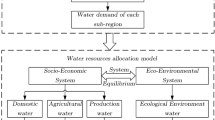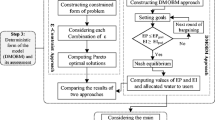Abstract
Due to the effect of climate change, rapid population growth and widespread water pollution, fresh water becomes an increasingly scarce natural resource. Optimal allocation of water resources is one of the most effective resolutions to deal with rising water demand and insufficient freshwater resources. This study proposes a fair approach for water resources allocation by employing the Sperner’s lemma to solve the conflicts of different objectives and those of competing regions. A multi-objective optimal allocation model is firstly formulated to generate the Pareto frontier surface, which maximizes the economic interest while minimizing the amount of organic pollutants. Subsequently, the approach searches for acceptable allocation schemes over the Pareto frontier surfaces through the total water quantity and envy-free constraints. The proposed model is applied to the middle and lower reaches of Hanjiang river basin in China. Results indicate that water allocation between multi-region can achieve Nash equilibrium by using the water conflict resolution method to select fair water allocation schemes, in which each region obtains its preferred water quantity. The proposed approach is proved effective for water resources management in the case study and demonstrates the potential for effective application in other basins.









Similar content being viewed by others
References
Allen RG, Pereira LS, Raes D, Smith M (1998) Crop evapotranspiration: guidelines for computing crop water requirements. FAO Irrigation and drainage, Rome
Babel MS, Das Gupta A, Nayak DK (2005) A model for optimal allocation of water to competing demands. Water Resour Manag 19(6):693–712
Brams SJ, Taylor AD (1995) An envy-free cake division protocol. Am Math Mon 102(1):9–18
Brekke L, Larsen MD, Ausburn M, Takaichi L (2002) Suburban water demand modeling using stepwise regression. J Am Water Work Assoc 94(10):65–75
Britz W, Ferris M, Kuhn A (2013) Modeling water allocating institutions based on multiple optimization problems with equilibrium constraints. Environ Model Softw 46:196–207
Burrows W, Doherty J (2016) Gradient-based model calibration with proxy-model assistance. J Hydrol 533:114–127
Cai XM, McKinney DC, Lasdon LS (2002) A framework for sustainability analysis in water resources management and application to the Syr Darya Basin. Water Resour Res 38(6):1–14
Chen L, McPhee J, Yeh WWG (2007) A diversified multi-objective GA for optimizing reservoir rule curves. Adv Water Resour 30(5):1082–1093
CWRC (Changjiang Water Resources Commission) (2011) Report on the comprehensive management plan on water resources for Hanjiang river basin, China
Deb K, Pratap A, Agarwal S, Meyarivan T (2002) A fast and elitist multi-objective genetic algorithm: NSGA-II. IEEE Transactions Evolutionary Computation 6(2):182–197
D'Exelle B, Lecoutere E, Van Campenhout B (2012) Equity-efficiency trade-offs in irrigation water sharing: evidence from a field lab in rural Tanzania. World Dev 40(12):2537–2551
Giordano MA, Wolf AT (2001) Incorporating equity into international water agreements. Soc Justice Res 14(4):349–366
Hipel KW, Fang LP, Wang LZ (2013) Fair water resources allocation with application to the south 579 Saskatchewan river basin. Can Water Resour J 38(1):47–60
HPDWR (Hubei Provincial Department of Water Resources) (2014) Dispatching schedules of Hubei provincial large reservoirs; Wuhan, China
Hu ZN, Wei CT, Yao LM, Li L, Li CZ (2016) A multi-objective optimization model with conditional value-at-risk constraints for water allocation equality. J Hydrol 542:330–342
Kasprzyk JR, Nataraj S, Reed PM, Lempert RJ (2013) Many objective robust decision making for complex environmental systems undergoing change. Environ Model Softw 42:55–71
Khare D, Jat MK, Sunder JD (2007) Assessment of water resources allocation options: conjunctive use planning in a link canal command. Resour Conserv Recycl 51(2):487–506
Kucukmehmetoglu M, Guldmann JM (2010) Multi-objective allocation of transboundary water resources: case of the Euphrates and Tigris. J Water Res Plan Man 136(1):95–105
Lee CS (2012) Multi-objective game-theory models for conflict analysis in reservoir watershed management. Chemosphere 87(6):608–613
Li M, Fu Q, Singh VP, Liu D (2018) An interval multi-objective programming model for irrigation water allocation under uncertainty. Agric Water Manag 196:24–36
Liu DD, Chen XH, Lou ZH (2010) A model for the optimal allocation of water resources in a saltwater intrusion area: a case study in Pearl River Delta in China. Water Resour Manag 24(1):63–81
Liu DD, Guo SL, Shao QX, Liu P, Xiong LH, Wang L, Hong XJ, Xu Y, Wang ZL (2018) Assessing the effects of adaptation measures on optimal water resources allocation under varied water availability conditions. J Hydrol 556:759–774
Lotfan S, Ghiasi RA, Fallah M, Sadeghi MH (2016) ANN-based modeling and reducing dual-fuel engine's challenging emissions by multi-objective evolutionary algorithm NSGA-II. Appl Energy 175:91–99
Marenco J, Tetzlaff T (2014) Envy-free division of discrete cakes. Discret Appl Math 164:527–531
Mortazavi-Naeini M, Kuczera G, Kiem AS, Cui L, Henley B, Berghout B, Turner E (2015) Robust optimization to secure urban bulk water supply against extreme drought and uncertain climate change. Environ Model Softw 69:437–451
Paul AK, Shill PC (2018) New automatic fuzzy relational clustering algorithms using multi-objective NSGA-II. Inf Sci 448:112–133
Peterson E, Su FE (2002) Four-person envy-free chore division. Math Mag 75(2):117–122
Raquel S, Ferenc S, Jr CE, Abraham R (2007) Application of game theory for a groundwater conflict in Mexico. J Environ Manag 84(4):560–571
Ren C, Guo P, Tan Q, Zhang L (2017) A multi-objective fuzzy programming model for optimal use of irrigation water and land resources under uncertainty in Gansu province, China. J Clean Prod 164:85–94
Salazar D, Rocco CM, Galvan BJ (2006) Optimization of constrained multiple-objective reliability problems using evolutionary algorithms. Reliab Eng Syst Saf 91(9):1057–1070
Sperner E (1928) Neuer beweis für die invarianz der dimensionszahl und des gebietes. Abh Math Sem: 265–272
Su FE (1999) Rental harmony: Sperner's lemma in fair division. Am Math Mon 106(10):930–942
Tabari MMR, Yazdi A (2014) Conjunctive use of surface and groundwater with inter-basin transfer approach: case study Piranshahr. Water Resour Manag 28(7):1887–1906
Tennant DL (1976) Instream flow regimens for fish, wildlife, recreation and related environmental resources. Fisheries 1:6–10
The Chinese State Council (2012) Opinions of applying the strictest water resources control system. (in Chinese)
Wang L (2005) Cooperative water resources allocation among competing users. University of Waterloo
Wang S, Huang GH (2012) Identifying optimal water resources allocation strategies through an interactive multi-stage stochastic fuzzy programming approach. Water Resour Manag 26(7):2015–2038
Wu XS, Wang ZL, Guo SL, Liao WL, Zeng ZY, Chen XH (2017) Scenario-based projections of future urban inundation within a coupled hydrodynamic model framework: a case study in Dongguan City. China. J Hydrol 547:428–442
Yang G, Guo SL, Liu P, Li LP, Liu ZJ (2017) Multiobjective cascade reservoir operation rules and uncertainty analysis based on PA-DDS algorithm. J Water Resour Plan Manage-ASCE 143(7):13
Yin JB, Gentine P, Zhou S, Sullivan SC, Wang R, Zhang Y, Guo SL (2018) Large increase in global storm runoff extremes driven by climate and anthropogenic changes. Nat Commun 9(1):438
Young HP (1994) Equity: in theory and practice. Chology 53:201–211
Acknowledgements
This study is financially supported by the National Key Research and Development Project of China (Grant NO. 2016YFC0402206), the National Natural Science Foundation of China (Grant NO. 51539009, 91647106, 51579183). The authors would like to thank the editor and anonymous reviewers for their comments, and Prof. Chong-Yu Xu for proofreading the final version, that helped improve the quality of the paper.
Author information
Authors and Affiliations
Corresponding author
Ethics declarations
Conflict of Interest
None.
Additional information
Publisher’s Note
Springer Nature remains neutral with regard to jurisdictional claims in published maps and institutional affiliations.
Rights and permissions
About this article
Cite this article
Tian, J., Guo, S., Liu, D. et al. A Fair Approach for Multi-Objective Water Resources Allocation. Water Resour Manage 33, 3633–3653 (2019). https://doi.org/10.1007/s11269-019-02325-5
Received:
Accepted:
Published:
Issue Date:
DOI: https://doi.org/10.1007/s11269-019-02325-5




